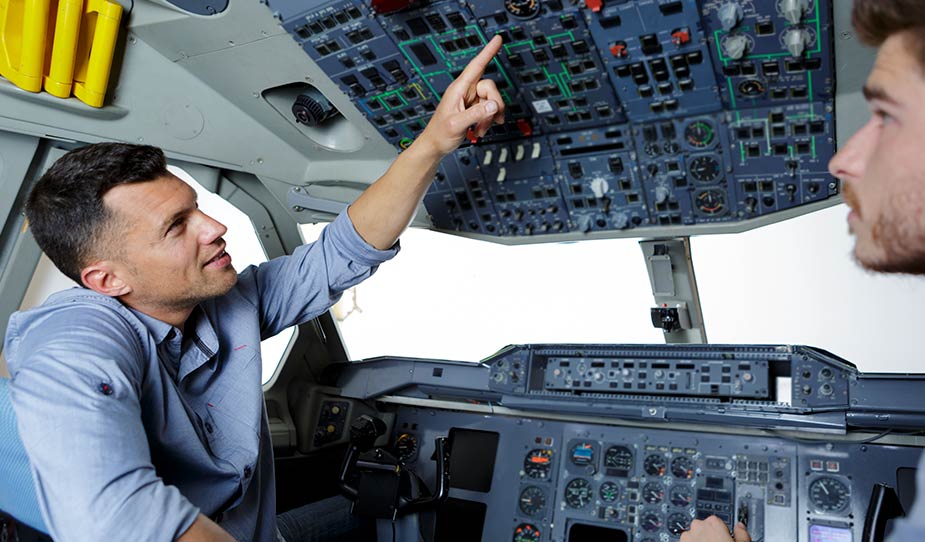Financing, Scholarships, Student Loans, and more
It's the age-old problem for anyone interested in pilot training... "How can I get money for flight training?" At Aviation Schools Online, we've been connecting prospective pilots with flight schools since 2001, and this question is always at the top of the list for anyone wanting to learn to fly, whether for a career, commuting, traveling or just for fun. In the past few years, we've seen several major sources of money for flight training completely dry up. But have no fear, pilot-to-be, there are still many ways to find money for flight training. Here, we offer you our Top 10 Ways to Pay for Pilot Training:
1. Attend an aviation college or university that offers financial aid programs
Aviation colleges and universities are a great path for aspiring airline pilots and commercial pilots for several reasons:
- Most airlines and many other pilot employers require a college degree.
- Federal student loans and grants are available to those who qualify.
- The pilot training you'll receive will be top-notch.
Colleges and universities that participate in federal financial aid programs are called Title IV schools. Title IV schools can offer many types of federal loan and grant programs, including Pell Grants, Direct Loans, and Perkins Loans. Schoold can assist a student or potential student apply for these loans, making the process much less painful. Many of the Featured Schools listed on this site offer Title IV grants and loans. Get more details regarding Federal Title IV Programs that can help pay for your flight training and education.
The University of North Dakota's John D. Odegard School of Aerospace Sciences offers students a variety of financing options, including VA benefits. Click here to contact UND regarding financing and training programs.
Spartan College of Aeronautics and Technology also has a wide variety of financial aid programs and options. Most Spartan aviation courses are approved for veterans by the Oklahoma State Accrediting Agency. You can use the Pre- and Post-9/11 G.I-Bill, V.A Rehabilitation, or the Tuition Assistance Program for your studies at Spartan. All of Spartan's aviation technical courses are covered under these programs. Also included is their Associate of Applied Science Aviation Maintenance Technology degree. Click here to contact Spartan about financing and training options.
2. Attend an accredited flight academy offering Federal Title IV programs and/or private financing
Flight academies are a great alternative to colleges and universities, especially for those who already have a college degree or whose career goals don't require a college degree. Flight academies typically offer accelerated training similar to the military and can get you your commercial pilot license in short order. However, not all flight academies are approved and accredited to offer Federal Title IV programs for student loans and grants, so be sure to do your homework before enrolling. Some academies offer private loans as well. Title IV flight academies are typically approved to offer the same or similar programs as those of Title IV colleges and universities. Get more details regarding Federal Title IV Programs.
3. Serve in the military and use your Post-9/11 GI-Bill benefits to help pay for flight training
The Post-9/11 GI-bill provides outstanding educational benefits to veterans, especially for those serving a minimum of 36 months active duty since September 10, 2001. Through a variety of programs, the Post-9/11 GI-Bill can help pay for tuition and fees, housing, and even books and supplies. To get the maximum benefit of your military service, look for aviation colleges, universities, and flight academies that participate in the Yellow Ribbon Program. The Yellow Ribbon Program may allow your Post-9/11 GI-Bill benefits to increase above and beyond normal limits. You will need to work closely with your school and VA office to work out all the details.
Check out our list of GI-Bill VA-Approved Aviation Schools.
4. Use your parents' GI-Bill benefits
Some unused Post-9/11 GI-Bill benefits are transferable to children. You can use GI-Bill benefits from your parents to help pay for pilot training. However, in order to be eligible to take advantage of this program, you must meet several conditions, which are spelled out on the GI Bill website.
5. Flight training scholarships and grants
A huge variety of scholarship programs and private grants are available to prospective pilots. It pays to look for opportunities from a wide variety of sources. The specific criteria and requirements for scholarships and grants varies. For example, some are open only to female applicants, while others may only be for beginning students. Scholarships can vary from just a few hundred dollars to more than $10,000 depending on the school chosen and degree or professional goals declared. For example, the Clay Lacy Professional Pilot Scholarship Program awards up to $12,500 per year to participants attending the University of North Dakota's John D. Odegard School of Aerospace Sciences. Some flight clubs and organizations also offer grants for training (start by checking with your local club). You can find more information on flight school scholarships and grants online.
6. Work your way through flight school.
Working at a flight school or on-airport operation can provide big benefits. Get out to the airport and immerse yourself in the business of aviation and doors will open for you. You may have to take an entry-level job and work your way up, but it could be worth it. For example, many flight schools offer discounted instruction and aircraft rental rates to employees, so you may be able to earn your licenses for less. Once you get your flight instructor certificate (CFI), you can start building your hours in flight training and work your way up the aviation job ladder. Some flying clubs offer reduced flying costs to members, and some non-collegiate flight schools allow their students to work part-time in exchange for flight time. Taking advantage of a work-for-flight-time arrangement also gives you invaluable aviation industry experience. It's a great way to go if you already have your degree or if your aviation goals don't include jobs that require a college degree. Airnav.com is a great place to find on-airport businesses that might hire you.
7. Get a loan from Pilot Finance, Inc.
Pilot Finance is a private lending institution specializing in loaning money for flight training for private pilot and/or instrument rating candidates in both airplanes and helicopters. According to the Pilot Finance website, you can apply for a loan for flight training in the United States only at Part 61 and 141 flight schools in a traditional training (non-accelerated) environment. Students with good credit and reasonable debt-to-income ratios can expect lower interest rates and payments. Loans are available for any dollar amount consistent with your credit score and debt-to-income ratio. Get all the details at pilotfinance.com.
8. Get a private loan from a bank, credit union, person-to-person lender, family member, or friend
You'll need a strong credit rating or a solid co-signer to get a loan from a bank or credit union, but a private loan may not require a credit check at all. Private education funding from banks is tough to get these days, but qualified borrowers can usually make it happen. Getting a loan from family or friends can be much easier IF you know the right people, and these loans often have much better interest rates than banks. The growing market for person-to-person loans is yet another option, with lending sites such as Prosper and Lending Club matching individuals who need small loans with willing lenders.
9. Get a credit card specifically for pilot training
Today, most flight training students use a credit card for at least some or all of their flight training financing. Many credit cards have advantages over traditional loans, including zero-interest-rate introductory periods ranging from six months to more than a year, cash-back offers on certain types of purchases, and programs for people with bad credit or no credit. You also have the flexibility to use your credit any way you choose. If you decide a credit card is right for you, be smart about it and avoid high-interest rates and pay down your balance as quickly as possible. If you have a history of not paying off your credit cards, stay away from this option.
10. All of the above
Chances are you may need a combination of the resources listed above for your flight training financing. There's no need to limit yourself to only one source of funding if it makes better sense to tap multiple options. Grants and scholarships are highly sought after because they don't have to be repaid, but this free money is rarely enough to complete your flight training goals anyway. So carefully review and consider all of your funding options. And look for helpful advice wherever you can find it, from flying clubs and flight-training centers to aviation supply shops and flight magazines. The bottom line is that if you really, really want to learn to fly, you'll do whatever it takes to earn your wings. And that's a good thing, because nothing is sweeter than achieving your lofty aviation goals. So go out there and make it happen!

